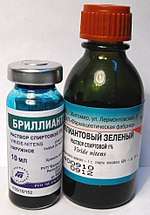Brilliant green (dye)
Brilliant green (also known as zelyonka or zelenka) is one of the triarylmethane dyes. It is closely related to malachite green.[1]
_Structural_Formula_V1.svg.png) | |
| Names | |
|---|---|
| Other names
Malachite green G, Emerald green, Solid green JJO, Diamond green G, Aniline green, Benzaldehyde green, Fast green J | |
| Identifiers | |
3D model (JSmol) |
|
| ChEBI | |
| ChEMBL | |
| ChemSpider | |
| ECHA InfoCard | 100.010.174 |
PubChem CID |
|
| UNII | |
CompTox Dashboard (EPA) |
|
| |
| |
| Properties | |
| C27H33N2.HO4S | |
| Molar mass | 482.64 g/mol |
| Melting point | 210 °C (410 °F; 483 K) (decomposes) |
| 100 g/L a 20 °C | |
Except where otherwise noted, data are given for materials in their standard state (at 25 °C [77 °F], 100 kPa). | |
| Infobox references | |
Uses

Brilliant green has been used to color silk and wool.
It is indicated for disinfection of fresh postoperative and post-traumatic scars, umbilical cord of newborns, abrasions, cuts, and other violations of the integrity of the skin, in the treatment of purulent-inflammatory processes of the skin - hordeolum ("barley"), meibomite, blepharitis, pyoderma, local furunculosis, carbunculosis, staphylococcal infection [16]. It is applied externally, the drug is applied to the damaged surface, capturing the surrounding healthy tissue [1] [24]
In Russia and Ukraine (and much of the rest of the former Soviet Union), the dilute alcoholic solution of brilliant green is sold as a topical antiseptic, also known under a Latin name solutio viridis nitentis spirituosa and the colloquial Russian name of zelyonka (зелёнка, lit. 'green thing'),[2] which is zelenka (зеленка) in Ukrainian.
Brilliant green is a visible light-activated photocatalyst in organic synthesis.[3]
Safety and toxicity
Brilliant green is effective against Gram-positive bacteria . The main advantage of brilliant green over the more common antiseptics such as iodine is that it does not irritate mucous membranes as harshly on accidental contact. Soviet medical doctrine deemed it "not for use on mucosa" and cautions that it can cause eye damage and ophthalmic chemical burns and burns the eye, at least in the typical formulations produced for medical use.
Brilliant green induces vomiting when swallowed and is toxic when ingested.[4] The compound may lead to serious injuries if it comes to contact with the eye, even result in bilateral blindness due to corneal opacification.[5]
Politics
In Russia and sometimes in Ukraine, zelyonka has been used to physically attack political opponents.[6] Since 2016, many opponents of the Russian government of Vladimir Putin have been splashed with zelyonka, including Alexei Navalny, Igor Kalyapin, liberal journalists, Nadya Tolokonnikova, Maria Alekhina, Lyudmila Ulitskaya, Ilya Varlamov and Mikhail Kasyanov.[7]
References
- Gessner, T.; Mayer, U. (2002), "Triarylmethane and Diarylmethane Dyes", Ullmann's Encyclopedia of Industrial Chemistry 6th Edition, Weinheim: Wiley-VCH, doi:10.1002/14356007.a27_179, ISBN 3527306730
- Balabanova, Maria; Popova, Liudmila; Tchipeva, Rositsa (2004). "Dyes in dermatology". Disease-a-Month. 50 (6): 270. doi:10.1016/j.disamonth.2004.05.002.
- Rogers, David A.; Bensalah, Adam T.; Espinosa, Alvaro Tomas; Hoerr, John L.; Refai, Fares H.; Pitzel, Amy K.; Alvarado, Juan J.; Lamar, Angus A. (2019-06-07). "Amplification of Trichloroisocyanuric Acid (TCCA) Reactivity for Chlorination of Arenes and Heteroarenes via Catalytic Organic Dye Activation". Organic Letters. 21 (11): 4229–4233. doi:10.1021/acs.orglett.9b01414. PMID 31140821.
- Narat, J. K. (1931). "Brilliant Green: A Clinical Study of Its Value As a Local Antiseptic". Annals of Surgery. 94 (6): 1007–1012. doi:10.1097/00000658-193112000-00003. PMC 1391517. PMID 17866691.
- CID 12449 from PubChem
- "How the Soviet-Era Antiseptic "Zelyonka" Became a Political Weapon in Russia and Ukraine". 6 May 2017. Retrieved 26 September 2017.
- "Why are Russian opposition leaders' faces turning green?". The Economist. May 10, 2017. Retrieved May 11, 2017.